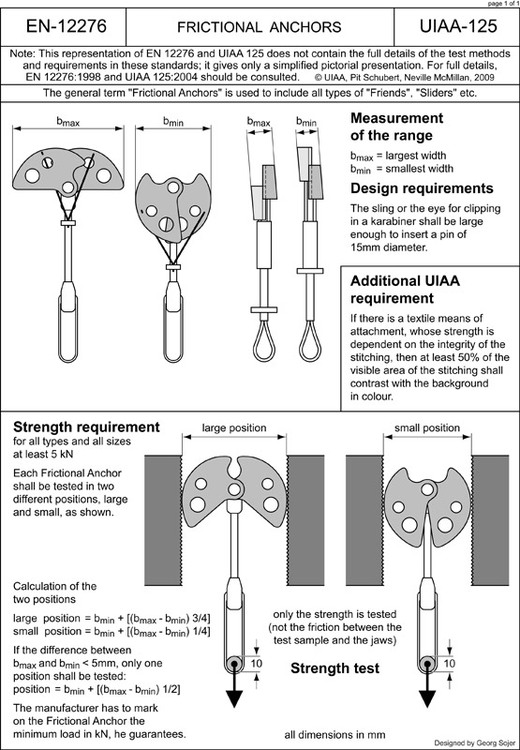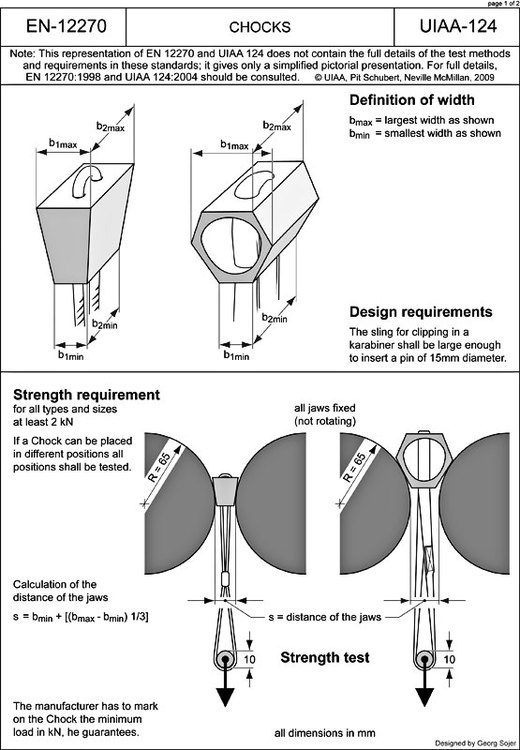Is 6kN really the magic number?
|
|
|
|
|
Yoi 2 are talking gibberish.
|
|
|
Some others have also chimed in claiming there is no hard limit. Yes, there is a hard limit (as given by Jim Titt). And the hard limit has nothing to do with the FF2 fall as many are alluding to previously. It is more relevant to look at the dreaded FF0 fall (as Jeff implies). A piece that can (barely) hold body weight (aid) is not guaranteed to hold a FF0 fall. The simplest way reasoning about it is that if you let the belayer lock off as you hangdog, a rough estimate is that the top piece of gear will feel the force twice that of your body weight (with friction and other details it might be in the range 1.6x or 1.7x). The "standard" UIAA climber is assumed to be 80kg, equivalent to 800N. A piece rated for 1kN (=1000N) could (possibly) hold the body weight of an aid climber (800N), but would (likely) fail if you hangdog on it (2x800N = 1.6kN or with some friction losses: 1.6x800N = 1.3kN). A FF0 fall generates a little more force on the top piece than gently hangdogging on it, so that's why the limit for lead gear is higher than this theoretical 1.3kN or 1.6kN. With some high school physics assuming the rope is an ideal spring, ignoring friction losses, and ignoring any effects of the dynamics of the belayer, I think (anyone with a more recent background of physics/math might correct me here) the maximum force on the top piece of gear turns out to be 4x your body weight (3.2kN for the "standard" UIAA climber) at a FF0 fall. Yes, I know, too much theory. But at least it gives some understanding on where these numbers come from. Jim Titt wrote: |
|
|
|
|
|
I used this in a Presentation once, Most falls I take are just over 5kn for a fatter guy like me, but even so. 5 feet past my last placement, and You're gonna bet that is well over the 4kn's worth of force. http://ferforge.tripod.com/Srt002.htm |
|
|
Ska Ggs wrote: Wow, Tripod still exists. So much nostalgia and a little bit of horror at the bad poetry websites I made in middle school. EDIT: That calculator is also wrong. I put in 45ft of rope and 15ft since last anchor, and got FF=1.333. FF=h/L where h = 2*(distance since last anchor) and L = length of rope, so the correct answer should be FF=.667 |
|
|
David Kerkeslager wrote: No idea why except that the nut standard is considerably older than the one for cams and usually the values (for all climbing equipment) are a combination of some vague theoretical number and historic experience about what works. We did a project logging sport climbers for a summer, it´s actually quite cheap if you use data-logging decelerometers. No, the information isn´t going to be made public! |
|
|
Jim Titt wrote:
|
|
|
King Tut wrote: What! lol. Do you have evidence to back this theory up? This is not an accurate way of calculating forces in falls, number one you're not even accounting for the most relevant factor the mass of the object falling, two, I'm not sure the relationship is linear. According to your model if someone (Let's say they weigh 200lbs) has a 100 feet of rope out and takes a 50 foot whipper then it's only going to put 2kn (450lbs of force) on the gear, I suspect it would be much greater. There used to be only calculator to estimate this, though I can't find one at the moment. |
|
|
DrRockso wrote: Napkin math assumes the relationship is linear. Having taken a 100' fall with 200' of rope out it is remarkably gentle I assure you. :) I also weigh north of 200# :P. |
|
|
Do people still use Screamers? I liked to used those when clipping small pieces. |
|
|
6kN is not a magic number. It has simply been observed in practice that 6kN gear usually holds. Even 5kN gear usually holds, but its failure rate even when well placed may well be several times higher. On the other hand, I vaguely recall an old Chris Harmston quote to the effect that 10kN rated Black Diamond pro never failed in the field. A new UIAA rated rope can generate forces up to 12kN in an 80kg drop test. Add in the near doubling of force that can occur when a rope is slingshot 180 degrees across a carabiner, and the theoretical magic number for gear safety is 20kN. Why does reality turn out better than theory here? Here are a few plausible excuses. 1. Most effective fall factors are well under 2. However, the force does not decrease linearly. If you wanted to oversimplify, decreasing as the square root, so FF 0.5 represents half the peak force compared to FF2, is closer to reality. 2. Most ropes are rated to peak forces well under 12kN when new, not exactly equal to it. Note that a beat-up rope that seems bouncy in a short fall may still exert an abnormally high peak force in a harder fall. 3. The stamped strength of UIAA rated rock protection is less than its average strength. 4. The climber may weigh well under 80kg. If most of these advantages are not present, then gear that is normally adequate may fail. This is pure speculation so I'm being vague, but over a decade ago there was a fatal accident that left behind an unusual pile of mangled gear. Most assume the gear's performance was compromised by underextended slings, and so do I. But I think it's also likely that other contributing factors included a heavy climber, a beat-up rope, and an effective fall factor possibly exacerbated by the same underextension. |
|
|
I took a near-factor 1 fall onto a #3 BD nut, rated to 5 kN. Saved me from hitting the deck. I still carry the nut, which has a nice groove in it from where it contacted the rock. |
|
|
II thought that reason why lead gear is tested to 5kn is because is because in a fall we do nay generate more than 5kn of force applied on the gear. It is stupid to certify gear that will break in a fall |
|
|
JulianG wrote: It's not stupid at all. Just because a piece of gear will break in SOME falls doesn't mean it will break in ALL falls. I'd guess a 3kN piece will fail in a lot of falls (haven't fallen on my white tricam) but I've placed the white tricam over my head so I can do a tricky sequence on short top rope, and in that situation, where the FF<0.1, I'm fairly certain a fall isn't going to generate 3kN. Part of what you sign up for when you do trad is that you're not always going to have a 10kN placement available to you. In those situations, it's usually safer to place a 3kN piece than to place nothing. And in case it isn't obvious, they can't just make stronger gear. These, for example, fit in some very small cracks, so small that there's very little material to even hold weight, and they have to forge the stoppers directly onto the swaged wire just to get it to 2kN for the smallest piece. |
|
|
David Kerkeslager wrote: Well right. But I'm talking about UAII certifications they only require 2kn for stoppers and 5kn. If industrial equipment is rater to 25 kn it is made to hold 50 kn. Maybe in climbing we generate only a max of 2kn on gear
|
|
|
JulianG wrote: No. Not trying to be rude here, but this idea is unambiguously and dangerously wrong. |
|
|
King Tut wrote: It definitely isn't a linear relationship. IIRC, it's closest to a logarithmic relationship. But, as it has been stated upthread, when you're working with gear in the range of 6kN and under, you shouldn't be concerned with gear rating. The numbers you ought to be concerned about is millimeters and making sure that your placement is good fit with the rock on a micro level scale. The difference between a good placement and shit can sometimes be a fraction of a millimeter. |
|
|
John Wilder wrote: Also keep in mind that the gear rating is a "true number" only in a lab test environment. We are unlikely to get the ideal direction of pull, same surface area contact ... when placing gear in rock. And rock quality may not be as strong as the steel test bench in the lab. So the number stamped on the piece of gear is more a hint of a maximum what you can possibly achieve when placing it. |
|
|
Patrik wrote: Of course rock quality can play a role when a piece pulls out . But the strength of the gear relates to when the piece breaks. Of course this assumes a relatively good placement. Otherwise the 10 kN cams that fail at low loads because they were placed poorly would have to have completely different ratings. How many hairs do we want to split |

 Continue with onX Maps
Continue with onX Maps Continue with Facebook
Continue with Facebook
























